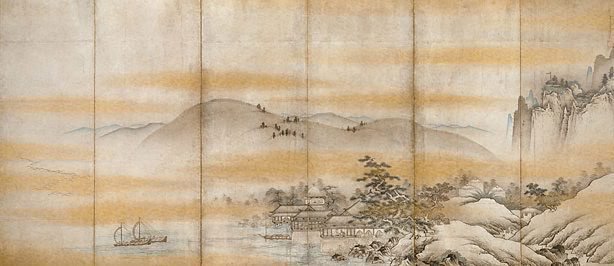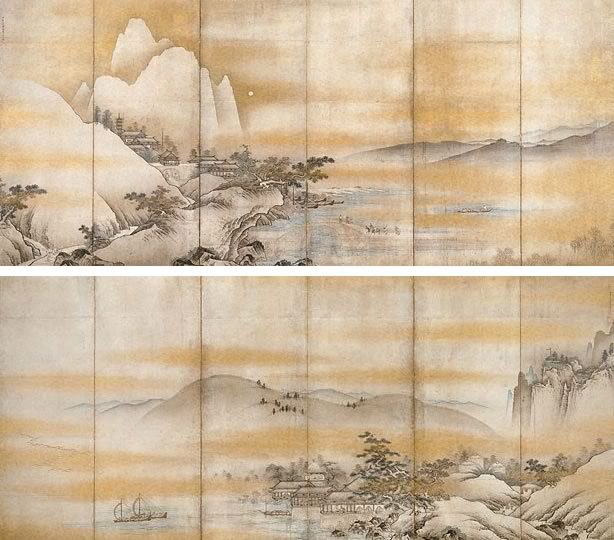

-
Details
- Place where the work was made
-
Japan
- Period
-
Edo (Tokugawa) period 1615 - 1868
→
Japan
Momoyama period 1573 - 1615 → Japan - Date
- early 17th century
- Media categories
- Screen , Painting
- Materials used
- pair of six-panel screens (byobu); ink and gold wash on paper
- Dimensions
-
a - right screen - (no moon depicted), 155 x 352 cm, image
a - right screen - (no moon depicted), 173 x 370 cm, sheet
b - left screen - (moon in centre), 155 x 352 cm, image
b - left screen - (moon in centre), 173 x 370 cm, sheet
- Signature & date
Signed u.l. [left screen], in Japanese, ink [inscribed] "Sesshu yondai Unkoku Tôeki hitsu [drawn by Unkoku Tôeki, Sesshu IV] [& artist's seal]". Not dated.
Signed u.r. [right screen], in Japanese, ink [inscribed] "Unkoku Tôeki hitsu [drawn by Unkoku Tôeki, Sesshu IV] [& artist's seal]". Not dated.- Credit
- Purchased with funds provided by Kenneth Myer 1985
- Location
- Not on display
- Accession number
- 166.1985.a-b
- Copyright
- Artist information
-
Unkoku Tōeki
Works in the collection
- Share
-
-
About
By the 1400s panoramic landscape screens in the 'suibokuga' style were an established and popular genre. The Japanese 'suibokuga' artists adopted Chinese styles, motifs, compositions and subjects but since they were unfamiliar with Chinese scenery, their landscapes often assumed an imaginary quality. Here Toeki combines the gentle rolling hills native to Japan with the soaring, ragged peaks typical of China. With its high, dense land formation either side of an expansive misty lake and use of atmospheric perspective, the composition is typical of the 'suibokuga' landscape tradition.
Toeki's screens recall earlier depictions of the popular Chinese theme of the Eight Views of the Xiao Xiang rivers (in modern Hunan province in the southern part of China). The themes had inspired many Chinese poets and painters and from the 1300s Japanese painters as well. A formula evolved where each of the Eight Views was identified by a set poetic title such as 'Returning sail off distant shore' or 'Wild geese descending to sandbar': Toeki's response to these themes form vignettes within his overall composition. His figures of gentleman scholars have also evolved from Chinese prototypes. Gentlemen scholars were an influential class in Confucian China but one that did not exist in Japan. The two figures on the left are scholars, followed by their servant who carries their zither. Other figures can be seen within the pavilions conversing and reading, activities associated with the ideal of the cultivated gentleman.
The Asian Collections, AGNSW, 2003, pg.209.
-
Places
Where the work was made
Japan
-
Exhibition history
Shown in 4 exhibitions
Great gifts, great patrons, Art Gallery of New South Wales, Sydney, 17 Aug 1994–19 Oct 1994
Art of the brush, Art Gallery of New South Wales, Sydney, 23 Sep 1995–12 Nov 1995
The art of Japanese screen painting, Art Gallery of New South Wales, Sydney, 06 Nov 2004–06 Feb 2005
In one drop of water, Art Gallery of New South Wales, Sydney, 15 Jun 2019–21 Feb 2021
-
Bibliography
Referenced in 4 publications
-
Jackie Menzies, Art of the Brush - Chinese & Japanese painting calligraphy, Sydney, 1995, 16 (illus.), 17.
-
Jackie Menzies and Edmund Capon AM, OBE, Asian Collection Handbook, Art Gallery of New South Wales, Sydney, 1990, 6 (colour illus.).
-
Jackie Menzies (Editor), The Asian Collections Art Gallery of New South Wales, 'The World of Samurai Culture', Sydney, 2003, 208-209 (colour illus.).
-
Jacqueline Menzies, Art Gallery of New South Wales handbook, 'Asian', pg. 72-93, Sydney, 1988, 80-81 (illus.).
-
